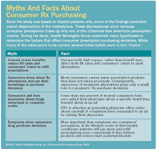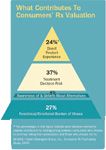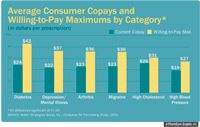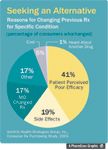Feelings Outweigh Facts
Pharmaceutical Executive
Imagine a person sitting alone in his living room suffering through a pounding migraine, while the rest of his family sits together around the kitchen table. He wants to join them, but his symptoms render him motionless. Now, imagine he has the choice to take two different drugs that promise to alleviate symptoms of his migraine. Drug A promises to help at the source of the problem by decreasing the frequency of swollen blood vessels around the brain, while drug B promises migraine-free days with more time to spend with the family. What do you think he would choose?
Imagine a person sitting alone in his living room suffering through a pounding migraine, while the rest of his family sits together around the kitchen table. He wants to join them, but his symptoms render him motionless. Now, imagine he has the choice to take two different drugs that promise to alleviate symptoms of his migraine. Drug A promises to help at the source of the problem by decreasing the frequency of swollen blood vessels around the brain, while drug B promises migraine-free days with more time to spend with the family. What do you think he would choose?
A study looks at what motivates consumers to fill a brand prescription based on how a patient values his or her therapy, what attributes are most important when choosing a drug, and what effect co-pays have on those decisions. Health Strategies Group surveyed more than 1,800 treated patients—who all suffer from one of six chronic and acute conditions including arthritis/pain, depression, diabetes, elevated lipids, hypertension, and migraine—and found that first and foremost, consumers perceive themselves as people, not patients. What they want as people shapes their choice of drugs, their perception of the value of treatment, and their view of therapeutic success.

Myths And Facts About Consumer Rx Purchasing
People, Not Patients
The survey found that when consumers embark on the process of obtaining or refilling prescriptions, their primary motivator is to find drugs that help them feel like they did before their illness. For example, if a 65-year-old woman suffers from arthritis that keeps her away from her family, she will seek a drug that relieves her her achy joints and muscles, so that she can join her grandchildren in the yard. In other words, consumers stay with the drugs that help them remove the roadblocks to a normal lifestyle.
According to the study of treated patients, they felt that having close relationships was the most important factor in their lives, followed by looking forward to the future, and being in control of daily activities.
Using emotional over rational decisions, people more often choose to use a medication because of how it makes them feel, instead of how it actually helps them. They value the brands they associate with improving their everyday lives. There are four driving factors that help consumers determine a prescription's value and motivate them to fill it. (See "What Contributes to Consumer's Rx Valuation".) These include:
- Functional and emotional burden of illness
- Awareness of beliefs about alternatives
- Treatment decision risk
- Direct product experience
1. Burden of illness For consumers, the perception that a disease will impair their relationships, outlook, and quality of life is their primary motivation for purchasing prescriptions, accounting for more than a quarter of the difference between consumers who do and who don't intend to continue a prescription medication. Going even further, consumers with symptomatic conditions like arthritis or depression discontinue therapy more often than consumers whose conditions have no symptoms, but who perceive that the drug helps them have a better quality of life. The opposite would result if the symptoms were more important than consumers' valuation of their quality of life.
2. Awareness of alternatives If a patient chooses to continue with his treatment, there is little chance he made that decision based on his knowledge of alternative drug treatments. Consumers learn about drugs from experience—few can name one prescription product they have not tried, and the majority cannot name any.
Awareness of prescription alternatives differs little among patients who intend to continue and those who intend to discontinue therapy. Only one percent of consumers who have switched medications attribute their decision to awareness of a different medication.
3. Treatment decision risk Consumers' perceptions of treatment decision risks are very important when deciding whether to continue their prescription, since this is where the emotional impact strikes. This evaluation accounts for more than one-third (37 percent) of the difference between consumers who continue and consumers who don't continue their prescriptions.

Frequency of Cholesterol-Lowering Products Association
The decisions risks fall under three categories: Social, emotional, and financial. For patients, the social risks include both the positive ("They'll think I'm smart for taking care of myself") and negative ("They'll think I'm weak because I need medicine") effects of taking a particular medication.
Among emotional risks are the effects on a patient's self-image of perfect health. When filling a new prescription, emotions may range from the positive ("I'm helping myself get better") to the negative ("Now something else is wrong with me").
Patients also consider the financial cost of drugs they need, although this is a minor component of decision risk for most insured consumers.
4. Direct product experience Experience with a specific product contributes 24 percent to consumers' decisions when evaluating whether to continue with therapy. Consumers who believe their drug contributes to a better quality of life are more likely to take it regularly. That is, they miss no more than one dose per week.
Paying the Price for Expectations
One of the most surprising findings is the minimal effect of co-pays on consumer decisions. What matters is not the amount of the copay, but the patient's expectation. When pharmacists request a co-pay amount that coincides with the consumer's expectations, only five percent discontinue therapy, even with co-pays as high as $85. However, when consumers encounter unexpectedly high co-pays, twice as many patients (10 percent) end up not filling the prescription.

What Contributes To Consumers Rx Valuation
When measuring perceptions of their prescription's value, the study showed that consumers who are willing to pay high prices for a medication (the "willing-to-pay maximums") see more value in a drug than consumers who are willing to pay only low co-pays. On average, consumers are willing to pay more than their current co-pays for medications, indicating that most consumers receive more value from their prescriptions than they curently pay for. In short, products that help people to forget they are patients are worth more to them.
"Co-pay Surprises"
When a patient goes to the pharmacy to fill a prescription, he or she will encounter a higher than expected co-pay, or "co-pay surprise," nearly 13 percent of the time. Eleven percent of those will fill the prescription. Conversely, of the 87 percent of patients who encounter the expected co-pay or a lower one, 86 percent fill the prescription.
The growing prevalence of the three-tier health plan makes for more co-pay surprises, which means patients will be on the lookout for alternatives. This group, known as "cost switchers," are more likely to believe that an alternative therapy is better than their current one.

Average Consumer Copays and Willing-to-Pay Maximums by Category*
But even as co-pays continue to become more important for insured consumers, the factor that affects most consumers' drug decisions is their perception of efficacy, which accounts for more than 40 percent of consumer's decisions to switch products. Cost accounts for only five percent and awareness of an alternative medication accounts for one percent of the decision. (See "Seeking an Alternative".)
Opportunity Knocks
The increasing number of cost switchers in the marketplace creates more opportunity but requires additional responsibility from manufacturers. Product manufacturers can anticipate the need to build consumer perceptions of brand value by communicating how their products contribute to a more fulfilling lifestyle among target groups. To accomplish this, brand teams need to develop consumer trust and reliability by doing the following:
Create educational support for physicians Doctors need to know what matters to their patients. What do they value? What do they look for when seeking treatment for their disease? Eighty percent of consumers rely on their physician to tell them about appropriate drugs for their conditions, so it's important to educate doctors and their staff about what patients want.
Create educational materials for patients Self-evaluation cards and informational material help consumers determine what they want out of their therapy. This also allows them to monitor the progress of their therapy and see if it is as effective as it should be.
Create brand value Design and deliver messaging to consumers that shows a brand's value. Positive messaging motivates patients to continue filling prescriptions.
Reducing noncompliance benefits everyone who is concerned about the patient. While physicians may naturally focus on symptoms and health metrics, attending to the emotional motivators for filling prescriptions improves compliance as it increases consumer satisfaction.

Seeking an Alternative
David Rees is a principal of Health Strategies Group based in Lambertville, N.J., where he directs the firm's consumer practice. He can be reached at drees@healthstrategies.com
Addressing Disparities in Psoriasis Trials: Takeda's Strategies for Inclusivity in Clinical Research
April 14th 2025LaShell Robinson, Head of Global Feasibility and Trial Equity at Takeda, speaks about the company's strategies to engage patients in underrepresented populations in its phase III psoriasis trials.
Beyond the Prescription: Pharma's Role in Digital Health Conversations
April 1st 2025Join us for an insightful conversation with Jennifer Harakal, Head of Regulatory Affairs at Canopy Life Sciences, as we unpack the evolving intersection of social media and healthcare decisions. Discover how pharmaceutical companies can navigate regulatory challenges while meaningfully engaging with consumers in digital spaces. Jennifer shares expert strategies for responsible marketing, working with influencers, and creating educational content that bridges the gap between patients and healthcare providers. A must-listen for pharma marketers looking to build trust and compliance in today's social media landscape.
Amgen’s Imdelltra Demonstrates Significant Overall Survival Improvement in Small Cell Lung Cancer
April 16th 2025In the Phase III DeLLphi-304 trial, patients with small cell lung cancer administered Imdelltra achieved a statistically significant and clinically meaningful improvement in overall survival compared to standard-of-care chemotherapy.
